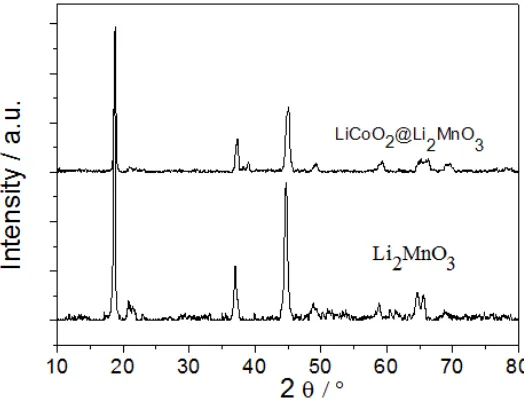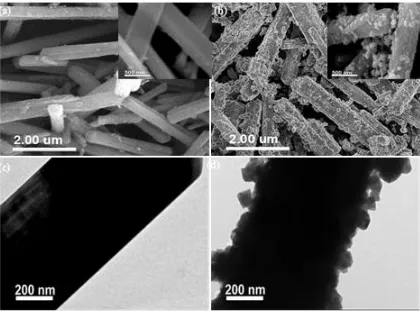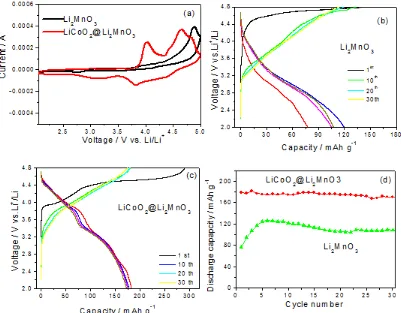Int. J. Electrochem. Sci., 9 (2014) 6182 - 6190
International Journal of
ELECTROCHEMICAL
SCIENCE
www.electrochemsci.orgCoaxial LiCoO
2@Li
2MnO
3Nanoribbon as a High Capacity
Cathode for Lithium Ion Batteries
F.X. Wang1, S.Y. Xiao1, Z. Chang1, M.X. Li1, Y.P. Wu 1,*, R. Holze2,*
1
New Energy and Materials Laboratory (NEML), Department of Chemistry & Shanghai Key Labo-ratory of Molecular Catalysis and Innovative Materials, Fudan University, Shanghai 200433, China 2Technische Universität Chemnitz, Institut für Chemie, AG Elektrochemie, D-09107 Chemnitz, Germany
*
E-mail: wuyp@fudan.edu.cn; rudolf.holze@chemie.tu-chemnitz.de
Received: 18 July 2014 / Accepted: 8 August 2014 / Published: 25 August 2014
Coaxial LiCoO2@Li2MnO3 nanoribbons prepared by a new method have been characterized with X-ray diffraction, field emission scanning electron and transmission electron microscopy. As cathode material for lithium ion batteries they deliver a high reversible capacity of 180 mAh g-1, which is very stable without capacity fading during cycling in the range of 2.0 - 4.8 V. This is different from the traditional Li2MnO3 prepared viasolid solution method.
Keywords: Lithium ion battery; cathode; Li2MnO3; coaxial; nanoribbons
1. INTRODUCTION
channel for high voltage batteries with very high specific capacity. This makes Li2MnO3 an appealing candidate for the next generation cathode material for lithium ion batteries.
Recently, nanostructured materials have been studied extensively for energy-related applica-tions [16,17]. It is well known, that nanosized particles can have shorter diffusion pathways for Li+ ions, thus allowing fast Li+ ions diffusion in the bulk of the electrode and towards the elec-trode/electrolyte interface. However, applications of single-phase nano-materials are limited due to their intrinsic material properties such as low conductivity, low mechanical stability and associated side reactions. To surpass the limitations associated with single phase nano-materials, various hybrid nanostructures have been proposed [18-20]. For hybrid nanostructured materials, strong synergetic effects can be achieved by integrating the individual components with all the desired functions of each component. Among them, coaxial architectures have attracted special attention [21-26]. For example, a type of nanodevice constructed from Cu@C coaxial nanocables was fabricated by using a focused-ion-beam (FIB) deposition technique [22].Coaxially structured Ag/carbon hybrid electrodes were prepared as the anode for lithium ion micro-batteries, which show excellent electrochemical performance [24]. Coaxial carbon nanospheres/carbon nanotubes exhibit a good combination of high specific discharge capacity and volumetric capacity, good cycling stability and rate capability [26]. Here, we report on LiCoO2@Li2MnO3 coaxial nanoribbons as a cathode material for lithium ion batteries. Interestingly, this novel composite shows high reversible capacity and excellent cycling behavior, which is competitive with those of solid solution materials (such as 0.5Li2MnO3-0.5LiMn0.5Ni0.5O2 [27], LiNiPO4-coated 0.5Li2MnO3-0.5LiCoO2 [28], and 0.3Li2MnO3-0.7LiNi1/3Co1/3Mn1/3-O2 [29]).
2. EXPERIMENTAL
Material characterization: X-ray diffraction (XRD) patterns were collected using a BrukerD4 X-ray diffractometer (Bruker, Germany) with Ni-filtered CuK radiation (40 kV, 40 mA). Scanning
electron micrographs (SEM) were obtained with a Philip XL30 microscope (Philips, The Netherlands) operated at 25 kV. Field emission scanning electron micrographs (FESEM) were obtained with a FE-SEM-4800-1, and transmission electron micrographs (TEM) were acquired using a JEOL JEM-2010 transmission electron microscope (JEOL, Japan) operated at 200 kV. Samples were first dispersed in ethanol and then collected using carbon-film-covered copper grids for analysis.
Electrochemical measurements: The working electrode was prepared by coating the N-methyl-2-pyrrolidone (NMP)-based slurry containing the prepared Li2MnO3 (or LiCoO2@Li2MnO3) nanoribbon, acetylene black and PVDF in a weight ratio of 8 : 1 : 1 on aluminum foil (thickness: 20
m) using the doctor-blade technique. The coated foils were punched into circular pieces (d =15 mm) and dried at 120 °C for 12 h under vacuum. The mass loading of Li2MnO3 (or FePO4@Li2MnO3) was around 24 mg cm-2. Celgard 2730 membrane and LIB315 (a standard 1 mol·l-1 LiPF6 solution in a 1:1:1 mixture of ethylene carbonate, dimethyl carbonate, and diethyl carbonate, Guotaihuarong Chemical Plant) were used as the separator and the electrolyte, respectively. All cells were assembled in an Ar-filled glove box. The cyclic voltammetry was obtained between 2.0 and 5.0 V at a scan rate of 0.1 mV s-1. The cycling test was carried out by a Land tester (CT2001A) between 2.0 and 4.8 V (vs. Li+/Li) at a current density of 10 mA g-1.
3. RESULTS AND DISCUSSION
Scheme 1. The preparation process of the coaxial LiCoO2@Li2MnO3 nanoribbons.
Figure 1. X-ray diffraction pattern of Na0.44MnO2
Then Li0.44MnO2 were obtained via Na0.44MnO2 nanoribbons as precursor followed by ion-exchange to replace Na+ by Li+. The sodium/lithium ion-exchange experiment was performed in a mol-ten salt composed of a mixture of LiNO3 (88 mol%) and LiCl (12 mol%) at 400 °C for 1 h in air. Then the Li2MnO3 was obtained by oxidation of Li0.44MnO2 nanoribbon. Finally, Li2MnO3 nanoribbon was decorated with LiCoO2 nanoparticles using a sol-gel method.
The XRD diffraction patterns of the Li2MnO3 and the LiCoO2@Li2MnO3 nanoribbons are shown in Fig. 2. Both samples show a layered structure with a C2/m space group, with alternating Li layers and transitional metal layers separated by oxygen layers. The superlattice peaks between 20 and 25° in the XRD, which are not observed in other layered materials, are due to the ordering of Li/Mn in the transitional metal layers [7]. However, it is noticeable that coexisting LiCoO2 led to the reduction of the superlattice peaks derived from monoclinic Li2MnO3.
[image:4.596.166.428.523.723.2]
Figure 3. SEM and FESEM (insert) micrographs of the prepared (a) Li2MnO3 and (b) Li-CoO2@Li2MnO3 nanoribbons, and TEM micrographs of the prepared (c) Li2MnO3 and (d) LiCoO2@Li2MnO3 nanoribbons.
[image:5.596.90.510.74.385.2]
Figure 4. SEM micrographs of the prepared (a) Na0.44MnO2, (b) Li0.44MnO2 and (c) Li2MnO3.
Figure 5. (a) Cyclic voltammograms of the Li2MnO3 and LiCoO2@Li2MnO3 nanoribbons after the in tial charging process, the charge and discharge curves of (b) the Li2MnO3 nanoribbon and (c) the LiCoO2@Li2MnO3 nanoribbon between 2.0 – 4.8 V, and (d) cycling behaviors of the Li2MnO3 and LiCoO2@Li2MnO3 nanoribbons.
[image:6.596.105.506.248.561.2]
capacities of 142 mAh g-1 and 74 mAh g-1, respectively. The lower initial charge capacity of Li2MnO3 is due to incomplete activation, i.e. removal of Li2O from Li2MnO3 yielding active MnO2, at this current density [32]. The capacity increases over several cycles. Such an interesting phenomenon is commonly observed for Li2MnO3, it is attributed to the activation process during the subsequent cy-cles. However, LiCoO2@Li2MnO3 delivers a charge capacity as high as 270 mA h g-1 and a discharge capacity of 180 mA h g-1 (Fig. 5c). Two plateaus are present in the initial charge curve, which is consistent with the CV curve in Fig. 5a. The oxidation of Co3+ to Co4+ contributed to the former plateau [10]. The latter plateau starts at 4.5 V, which is generally known to be connected with the removal of oxygen from the cathode accompanied by diffusion of transition metal ions from surface to bulk where they occupy vacancies created by the removal of oxygen and lithium. [9, 33-37] The relatively low initial Coulombic efficiency for this composites is closely related to the irreversible lithium extraction/insertion from Li2MnO3. That is, lithium ions and O2 were first removed from the core component Li2MnO3 during the activation process on the initial charging, which yields a component MnO2 that can only accommodate one lithium ion per formula unit during discharging back to the rock-salt stoichiometry. Of course, not all the oxygen is lost as gas during the electrochemical process and some oxygen may react with the electrolyte [36,37]. Because of this, the as-prepared materials exhibit relative lower initial Coulombic efficiency compared to LiCoO2, LiNi1/3Co1/3Mn1/3O2, LiNi0.5Mn0.5O2 and other layered LiMO2 materials [10,11,38]. Increasing the initial Coulombic efficiency and blocking the oxygen emission are still challenges for such composites to achieve the goal of practical application lithium ion battery cathode, which deserves further investigation in the future. Studies utilizing various coatings are currenly underway.
The cycling behavior is presented in Fig. 5d. Initially the discharge capacity of the Li2MnO3 nanoribbon increases due to transformation of the Li2MnO3 [27]. It reaches the highest discharge capacity, 125 mAh g-1, in the sixth cycle, then decreases slowly. The main reason is the extraction of oxygen from the Li2MnO3 matrix during the activation process producing oxygen vacancies leading to structural destruction [39,40]. However, it has been observed that the LiCoO2@Li2MnO3 nanoribbon shows no evident capacity fading at 180 mAh g-1 during the initial 30 cycles. The enhancement in the capacity and cycling behavior for the coaxial LiCoO2@Li2MnO3 nanoribbon is attributed to the following reasons. Firstly, the LiCoO2 nanoparticles on the surface of Li2MnO3, unlike electrochemically inactive oxides such as ZnO, AlF3 and AlPO4 on the surface of solid-solutions based on Li2MnO3, can provide available lithium ions for the insertion [28,41,42]. Secondly, the LiCoO2 shell also contributes to reversible capacity from the CV and discharge and charge curves. Thirdly, the LiCoO2 coating helps to suppress the structural destruction associated with the removal of oxygen and lithium ions [43]. However, further evidence and work including optimizing the LiCoO2 content and increasing the initial Coulombic efficiency are needed.
4. CONCLUSION
and excellent cycling performance. Its good electrochemical performance is ascribed to the core Li2MnO3 providing highly reversible capacity and the shell LiCoO2 offering good protection. It pre-sents a promise as a next generation cathode material for lithium ion batteries with high capacity and working
References
1. W. Tang, Y.Y. Hou, F.X. Wang, L.L. Liu,Y.P. Wu, K. Zhu, Nano Lett. 13 (2013) 2036. 2. N. Sharma, D. Yu,Y. Zhu, Y.P. Wu,V. K. Peterson, Chem. Mater. 25 (2013) 754.
3. Y. Shi, J.Z. Wang, S.L. Chou, D. Wexler, H.J. Li, K. Ozawa, H.K. Liu, Y.P. Wu, Nano Lett. 13 (2013) 4715.
4. Y.S. Zhu, S.Y. Xiao, Y. Shi, Y.Q. Yang, Y.Y. Hou and Y.P. Wu, Adv. Energy Mater. 4 (2014) 1300647.
5. Y. Paik, C.P. Grey, C.S. Johnson, J.S. Kim and M.M. Thackeray, Chem. Mater. 14 (2002) 5109. 6. A. D. Robertson and P. G. Bruce, Chem. Commun. (2002) 2790.
7. G. Singh, R. Thomas, A. Kumar and R. S. Katiyar, J. Electrochem. Soc. 159 (2012) A410. 8. J.R. Croy, S.H. Kang, M. Balasubramanian and M.M. Thackeray, Electrochem. Commun. 13
(2011) 1063.
9. Y. Okamoto, J. Electrochem. Soc. 159 (2012) A152.
10. X. Wang, Q. Qu, Y. Hou, F. Wang and Y. Wu, Chem. Commun. 49 (2013) 6179. 11. F. Wang, S. Xiao, Z. Chang, Y. Yang and Y. Wu, Chem. Commun. 49 (2013) 9209. 12. F.X. Wang, S.Y. Xiao, X.W. Gao, Y.S. Zhu, H.P. Zhang, Y.P. Wu and R. Holze, J. Power
Sources 242 (2013) 560.
13. F.X. Wang, S.Y. Xiao, Y.S. Zhu, Z. Chang, C.L. Hu,Y.P. Wu and R. Holze, J. Power Sources 246 (2014) 19.
14. Y. Shi, S.L. Chou, J.Z. Wang, D. Wexler, H. J. Li, H.K. Liu and Y. Wu, J. Mater. Chem. 22 (2012) 16465.
15. Y. Hou, X. Wang, Y. Zhu, C. Hu, Z. Chang, Y. Wu and R. Holze, J. Mater. Chem. A 1 (2013) 14713.
16. Q. Zhang, E. Uchaker, S. L. Candelaria and G. Cao, Chem. Soc. Rev. 42 (2013) 3127. 17. J.N. Tiwari, R.N. Tiwari and K.S. Kim, Prog. Mater. Sci. 57 (2012) 724.
18. G. Yu, L. Hu, M. Vosgueritchian, H. Wang, X. Xie, J.R. McDonough, X. Cui, Y. Cui and Z. Bao, Nano Lett. 11 (2011) 2905.
19. M. Sathiya, A.S. Prakash, K. Ramesha, J.M. Tarascon and A.K. Shukla, J. Am. Chem. Soc. 133 (2011) 16291.
20. Q. Qu, Y. Zhu, X. Gao and Y.P. Wu, Adv. Energy Mater. 2 (2012) 950.
21. P. Wu, N. Du, H. Zhang, J. Yu and D. Yang, J. Phys. Chem. C 114 (2010) 22535. 22. W. Xu, Y. Zhang, Z. Guo, X. Chen, J. Liu, X. Huang and S.H. Yu, Small 8 (2012) 53.
23. H.W. Liang, Q.F. Guan, L.F. Chen, Z. Zhu, W.J. Zhang and S.H. Yu, Angew. Chem. Int. Ed. 51 (2012) 5101.
24. L. Fu, K. Tang, C.C. Chen, L. Liu, X. Guo, Y. Yu and J. Maier, Nanoscale 5 (2013) 11568; 25. J.H. Kim, K.H. Lee, L.J. Overzet and G.S. Lee, Nano Lett. 11 (2011) 2611.
26. Y. Chen, Z. Lu, L. Zhou, Y. W. Mai and H. Huang, Energy Environ. Sci. 5 (2012) 7898. 27. G. Singh, R. Thomas, A. Kumar, R.S. Katiyar and A. Manivannan, J. Electrochem. Soc. 159
(2012) A470.
28. D. Shin, C. Wolverton, J.R. Croy, M. Balasubramanian, S.H. Kang, C.M. L. Rivera and M. M. Thackeray, J. Electrochem. Soc. 159 (2012) A121.
6095.
30. X. Zhang, S. Tang and Y. Du, J. Phys. Chem. C 115 (2011) 2644. 31. X. Zhang, S. Tang and Y. Du, Phys. Lett. A 375 (2011) 3196.
32. H. Yu, H. Kim, Y. Wang, P. He, D. Asakura, Y. Nakamura and H.S. Zhou, Phys. Chem. Chem. Phys. 14 (2012) 6584.
33. A.R. Armstrong, M. Holzapfel, P. Nova, C.S. Johnson, S.H. Kang, M.M. Thackeray and P.G. Bruce, J. Am. Chem. Soc. 128 (2006) 8694.
34. N. Yabuuchi, K. Yoshii, S.T. Myung, I. Nakai and S. Komaba, J. Am. Chem. Soc. 133 (2011) 4404.
35. J. Lim, J. Moon, J. Gim, S. Kim, K. Kim, J. Song, J. Kang, W.B. Im and J. Kim, J. Mater. Chem. 22 (2012) 11772.
36. C. Yu, G. Li, X. Guan, J. Zheng and L. Li, Electrochim. Acta 61 (2012) 216.
37. J.R. Croy, D. Kim, M. Balasubramanian, K. Gallagher, S. H. Kang and M.M. Thackeray, J. Elec-trochem. Soc. 159 (2012) A781.
38. F. Wang, S. Xiao, Y. Hou, C. Hu, L. Liu and Y. Wu, RSC Adv. 3 (2013) 13059.
39. K. Kubota, T. Kaneko, M. Hirayama, M. Yonemura, Y. Imanari, K. Nakane and R. Kanno, J. Power Sources 216 (2012) 249.
40. J. Zheng, M. Gu, J. Xiao, P. Zuo, C. Wang and J. G. Zhang, Nano Lett. 13 (2013) 3824. 41. Y.K. Sun, M.J. Lee, C.S. Yoon, J. Hassoun, K. Amine and B. Scrosati, Adv. Mater. 24 (2012)
1192.
42. Y. Wu, A. Vadivel Murugan and A. Manthiram, J. Electrochem. Soc. 155 (2008) A635.
43. C. Li, H.P. Zhang, L.J. Fu, H. Liu, Y.P. Wu, E. Rahm, R. Holze and H. Q. Wu, Electrochim. Acta 51 (2006) 3872 and references therein.


